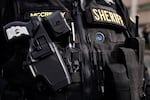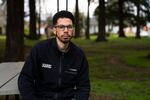Eagle Point officer Daniel Cardenas was 2 1/2 years into his first policing job when he followed Matthew Graves, 26, into a Carl’s Jr bathroom. It was September 2018, and Cardenas had attempted to stop Graves moments before for crossing a busy street against the light.
Graves had been diagnosed with schizophrenia in 2012 and his family said he didn’t trust police.
Cardenas entered the fast-food restaurant’s bathroom with his gun drawn, only to find Graves washing his hands. Cardenas yelled at him, demanding to see his hands and asked Graves what he was doing.
“I’m gettin’ food, shut the fuck up,” Graves replied, seemingly more annoyed than threatened by the interaction, before turning around to dry his hands.
Cardenas holstered his firearm and pointed his stun gun at Graves, who ignored instructions to get on the ground. Instead, Graves attempted to walk past the officer and leave the bathroom.

A screenshot of Officer Daniel Cardenas' body camera footage during his encounter with Matthew Thayer Graves in September 2018.
Jackson County District Attorney's Office
Cardenas pushed Graves back and used the stun gun on him seconds later. A second officer arrived and a scuffle ensued. The second officer mistook Cardenas’ stun gun on the ground for a gun and called out, “He has a gun.”
“He has a gun?” Cardenas replied, alarmed.
Eighty-two seconds after entering the bathroom, Cardenas shot and killed Graves.
The public knows these details because the entire incident, from Cardenas’ first contact with Graves on the street to the shooting in the bathroom, was captured on his body camera.
And yet, despite the footage and accompanying audio contradicting much of what Cardenas later told a grand jury, there was no indictment. No trial. No criminal charges brought that may have put the discrepancies between the footage and Cardenas’ testimony before a jury.
Related: Family of man shot by Eagle Point Police files wrongful death lawsuit
Eagle Point agreed to pay $4.5 million to settle a civil lawsuit filed by Graves’ family. Cardenas is still a police officer with the city.
At a time when many larger police departments in Oregon — Hillsboro, Gresham, Beaverton, Washington County — have started using body cameras, recent killings of Black men and people in mental health crises in nearby Vancouver, Washington, have spurred calls for adoption there as well.
Police accountability advocates hope body cameras will be a solution, but experts warn the effects of cameras on police behavior may not be significant. With city and county budgets tighter than they’ve been in years because of the pandemic, critics say body cameras are an expensive solution with unproven results.
Renewed calls for body cameras
Long before Feb. 4, the day Clark County Sheriff’s deputies shot and killed Jenoah Donald, a 30-year-old Black man, pressure for increased transparency and accountability had been building on law enforcement in Southwest Washington. After a string of shootings in 2019, the community demanded change.
In response, a dozen people from community organizations and activist groups were appointed to a task force overseeing the implementation of an outside group’s policy recommendations and a body-worn camera program.
“Body-worn cameras and dashboard cameras in Clark County, and specifically in Vancouver, are way past due,” said Shareefah Hoover, a member of the Vancouver NAACP legal redress committee and of the city’s Community Task Force on Policing. “We want policies that have teeth, and we want there to be consequences for violations of these policies in terms of the operations of these camera systems.”
Those calls for body-worn cameras have resurfaced, in part, because police killed Donald in a more rural part of the county, with no surveillance cameras or bystander footage to corroborate or refute the accounts of the officers involved. The case remains under investigation. In October, officers from the same sheriff’s department also shot and killed Kevin Peterson Jr., a 21-year-old Black man, during a botched drug sting operation.

Washington County Sheriff's Deputy Jarrod McCreary is seen wearing the department's new body camera system on March 8, 2021, in Hillsboro, Oregon.
Jonathan Levinson / OPB
As in most U.S. cities, the race and socioeconomic status of Southwest Washington residents are likely significant determinants for how a person feels about police, Hoover said. White, wealthy residents are more likely to feel like the police are aligned with their needs.
“What we are seeing is disproportionate policing, disproportionate use of force,” Hoover said. “We have a pattern here of Black men, who are a very small percentage of the Clark County population, having their lives taken at a much higher rate than the general population.”
Hoover is part of a diverse coalition of people throwing their support behind body-worn cameras. Even Vancouver Police Chief James McElvain has changed his stance.
In March 2019, days after Vancouver detectives shot 43-year-old Carlos Hunter during a traffic stop, McElvain said body and dash cameras were too much of a financial and staffing strain.
Related: After string of police shootings, Vancouver PD's top leader to officers: 'Stay the course'
“While we recognize that is a tool out there, we are not prepared to put those into operation anytime soon,” he said at the time.
Today, he’s fully on board.
“I think that the benefit that it will bring to our community by way of trust, transparency, accountability. ... I’m very supportive of it,” McElvain said in a recent interview with OPB. “In the aftermath of a number of very critical incidents ... the community wants to know what we’re doing.”
Pushback in Portland
Hoover’s sentiment isn’t as popular among activists a few miles away in Portland.
As police body and dashboard cameras have broken through institutional resistance over the past decade, clawing their way to mainstream acceptance and widespread use, Portland remains an outlier. The city’s police department is the largest in the country not wearing the devices.
Activists say they don’t believe the cameras would make a difference in Portland.
“Unfortunately, there’s hundreds of videos of killings. There’s thousands of videos of police violence, and it hasn’t prevented any of it,” said Lakayana Drury, executive director of the Portland-based nonprofit Word is Bond, whose mission is to rewrite the narrative between young Black men and law-enforcement through leadership development, critical dialogue, and education. “If you’re a Black person on the street today, you’re not feeling any safer with police because you think they have a body camera on them.”
Drury, who is also the alternate co-chair of the Portland Committee on Community Engaged Policing, said solutions like body cameras or implicit bias training are often seen as substitutes for hard work and significant changes needed to build trust between the police and the community.

Lakayana Drury, co-chair of the Portland Committee on Community Engaged Policing, sits for a portrait on March 7, 2021, in North Portland.
Jonathan Levinson / OPB
“We’re not coming down to a technology issue where people just don’t see it. What we’re coming down to is a human issue and a legacy of racism and white supremacy that is taught,” he said. “There are too many uneducated, adult white people who don’t understand systemic racism and white supremacy.”
Instead of cameras — which critics say also introduce a host of privacy concerns — Drury said we need to teach children about love, empathy and U.S. history. Videos like George Floyd being killed shouldn’t have to be the teaching tool, he said.
“Your parents should be the teaching tool,” Drury said. “We should be able to teach you that without showing you the most despicable things.”
Body camera programs are also expensive. It’s not just the initial equipment purchase that is costly. Departments also need to allocate money for storage, maintenance, and personnel to watch footage — redacting it when necessary — and archive it. Before Portland abandoned plans to institute one, the city had allocated almost $900,000 to purchase the cameras and $1.6 million in annual spending, which included five full-time positions.
Commissioner Jo Ann Hardesty, who has spent a career pushing for more police accountability and policing alternatives, said body cameras offer up a false promise.
“Why the heck would we pay millions of dollars for a system we have no access to and then pretend that it’s a police accountability system?” she asked during an interview with OPB last June. “Where’s the accountability in that?”
How cameras are used
Research into body cameras has found their impact varies widely. Assistant Professor Natalie Todak, who studies policing at the University of Alabama at Birmingham, said in departments with major issues, improvements can be dramatic.
“They bring (those departments) to that baseline ‘Here’s what you should have been doing all along’ level,” she said.
Todak pointed to the Rialto, California, police department, which was nearly disbanded in 2005 over constitutional issues with police behavior and discrimination. Complaints and use of force there declined substantially after instituting a body camera program.
But in other departments, ones that have gone through a federal consent decree or other reform processes, for example, the benefits are less clear and often temporary.
“I think that they are less likely to show those prominent declines because those agencies have done what they need to do to meet the threshold for good policing,” Todak said.
Positive results are also often temporary, too, a phenomenon Todak attributes to officers being hyperaware they are being recorded and actively modifying their behavior.
“You temporarily change things for a bit, then you just relapse back into business as usual,” she said, saying she’s observed it in real time as a researcher doing police ride-alongs. “At first, they’re on their best behavior. But it’s hard to hold that for 15 hours, and then you go back and you do the things the way that you were trained.”
One way body cameras can improve trust in police is through increased transparency when the public is able to see the footage. But that’s not always an option.
“That’s the debate that I think is going on right now,” Todak said “The general consensus is citizens want their agencies to have body. The question is, what should they do with the video once it’s there and once people are aware of it and want it?”
Every state and jurisdiction has found its own answer to that question. Oregon state law says footage is not subject to public release unless it involves use of force and the release is determined to be in the public interest. In Washington, footage is exempt from public release if it violates a person’s right to privacy. For example, law enforcement can hold the footage back from the public if it shows a minor, a deceased person or the inside of someone’s home.
Other transparency questions come into play, as well. If an officer is involved in a deadly use of force incident, it is common to allow that officer to view the footage before they give a statement to investigators.
The Police Executive Research Forum, the nonprofit organization that reviewed the Vancouver Police Department’s use of force and made recommendations, supports allowing officers to view body camera footage before making a statement in a deadly use of force incident.

Vancouver Police Chief James McElvain speaks Monday, March 18, 2019, in Vancouver, Washington.
Molly Solomon / OPB
“According to many police executives, the primary benefit to officer review is that it allows officers to recall events more clearly, which helps get to the truth of what really happened,” the organization wrote in a 2014 report on body-worn camera recommendations endorsing that approach.
Policies like that, which are deferential to police, can torpedo a program before it even gets off the ground, Hoover said.
“We want there to be prohibitions on officer pre-report viewing of cameras,” she said, ticking off a list of other policies she views as critical and likely sticking points with the Vancouver police. “If you’ve got dysfunction in a local law enforcement department, that will only be another tool to reinforce that dysfunction.”
McElvain, the Vancouver police chief, is unsure whether allowing officers to view footage is appropriate or not.
If an officer’s statement doesn’t align with what’s shown in the video, people will call them a liar or accuse the department of a cover up, he said. After a pause, he acknowledged the benefit in having an officer’s untarnished statement and proposed a middle ground popular with researchers.
“There’s another part of me that says, ‘You know what? The officer should provide a statement on that incident and then be able to watch the video and write a supplemental statement,’” he said.
After a grand jury chose not to indict the Eagle Point officer who shot and killed Matthew Graves, the lawyers representing Graves’ family issued a statement explaining their disappointment in the grand jury proceedings and outlining all the reasons they believed Officer Cardenas was in the wrong.
“In comparing the body cam footage, the body cam transcript, and the grand jury transcript, we have detected significant discrepancies in the testimony that Cardenas and Davis gave to the grand jury,” the statement reads, before listing seven discrepancies.
Despite the grand jury outcome in the face of what they believed was clear evidence of misconduct, David Linthorst, one of the attorneys representing the family, said he staunchly supports body cameras.
Linthorst said having an officer’s perspective and knowing what they were seeing is important to assessing their decision making. Plus, he said, the footage forces badly needed conversations.
“I’m not ready to throw the baby out with the bathwater,” Linthorst said. “It’s like Rodney King. To come out on the side of the officers and go through the mental gymnastics that took in the face of that video? I think that’s bringing us to change because it marginalizes you. If you’re going to look at this video and say, ‘No, I don’t see misconduct there,’ it puts you at an extreme.”
